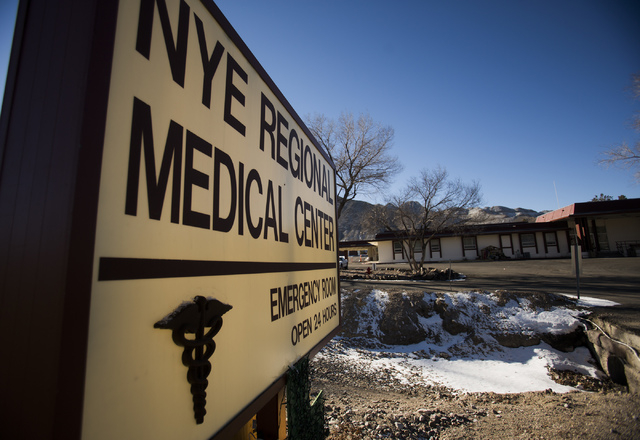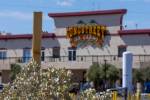Tonopah-area residents fret over financial health of local hospital
In 2006, Margie Downing suffered a ruptured aneurysm that often proves fatal even with the best treatment.
However, recalled husband Duane Downing who is also a Tonopah town council member, she was taken to Nye Regional Medical Center and successfully stabilized before being transferred to a larger and better-equipped hospital in Reno. She is not only alive but has made an almost complete recovery.
“If that hospital (Nye) were not here, she would not be here,” Duane Downing said. “I have seen that hospital save lives time and time again.”
So it sent a ripple of anxiety through the Nevada mining town, population 2,478, when the hospital filed for Chapter 11 bankruptcy protection in December. If it closed, seriously ill or injured residents would have to endure a 105-mile drive north on U.S. Highway 95 to Mount Grant General Hospital in Hawthorne or go 115 miles to Northern Inyo Hospital in Bishop, Calif.
“I am concerned,” said Ashley Pike, who helps manage Central Nevada Hardware with her father. “It is nice having a hospital so close. My parents are getting older and did need the ER once.”
Operating under the nonprofit corporation Primecare Nevada Inc., Nye Regional has encountered financial problems several times in the past. None were acute enough to force into the business version of the ER.
A DECEPTIVE BALANCE SHEET
At first glance, the balance sheet filed with the court gives the impression of a highly profitable business, with $14.4 million in assets against only $5.9 million in liabilities. However, more than half of the assets were listed accounts receivable from private pay patients, those without insurance who often pay only a fraction of their bills or nothing.
Hospital administrator Vincent Scoccia told creditors last month that two events had blindsided Nye in the past couple of years. On Jan. 1, 2012, hospitals across the country had to reprogram their payment systems to fit a new one the for both Medicare and Medicaid programs. The state and federal governments, however, delayed their switch until April 1, causing a three-month delay in critical cash flow.
Scoccia said that the hospital had to stall payments to vendors then work out a plan to recoup the shortfall over time.
“We had almost taken care of that,” he said.
Coming on top of that was the mid-2012 launch of a new computer system to meet federal requirements for electronic health records. Scoccia said the government had approved a $3.2 million grant to cover the expense but delivered only $600,000.
“2012 was a tough year, but we thought we were pulling out in 2013,” he said.
As the last year wore on, the burden of the $2.8 million promissory note for the health records system grew to the point of default, and debt restructuring talks went nowhere. Attempts to strike a deal with electronic health records contractor CPSI, based in Mobile, Ala., went nowhere and led to a threat to turn off the system and effectively the hospital with it, Scoccia said.
The Chapter 11 filing stopped CPSI from taking action.
NO PLAN YET REVEALED
Nye Regional has not yet revealed the outline of a reorganization plan to emerge from bankruptcy, but it has taken a number of steps to shore up operations. Still, bankruptcy cannot fix the endemic challenge faced by many rural hospitals of attracting medical personnel to small towns and generating enough revenue to cover costs consistently.
Two satellite clinics have been sold along with two vans to deliver mobile care. Scoccia said that he cut the management staff by half — the total personnel is about 60 — and no longer provides housing to doctors as a perk to lure them to practice in a town as small and remote as Tonopah. Instead, they stay at the hospital.
Although Nye’s license covers 44 beds, the hospital had dropped its extended care program and keeps only about 10 beds in operation. Even then, there are times when the hospital is completely empty.
“If you give up licensed beds, you never get them back,” Scoccia said.
Because the hospital has limited facilities, patients with more persistent problems will stay for about 48 hours, then transfer to someplace larger in Las Vegas or Reno, both about 230 miles away.
Some in the town have raised concerns in the past about how the cash flows between the hospital and several companies owned either by Scoccia or in conjunction with his ex-wife. Collectively, their companies own the hospital property, critical pieces of equipment such as CT scan and X-ray machines or provide services. One such company employs Scoccia rather than the hospital directly.
However, Scoccia pointed to court papers that list the companies as the largest creditors of the hospital as he declined payments to keep the hospital viable. The complex structure of companies became necessary when he bought the then-failing hospital 15 years ago from the county for $100,000 to be able to secure credit for the hospital itself.
He said he has not collected his own $120,000-a-year salary as administrator for at least six years.
“The operations have been financed through the ‘Bank of Scoccia,’ ” he said.
But those operations have also run into problems. A Nevada State Health Division inspection in August revealed numerous problems, such as discharging a patient to an unlicensed home providing care for dependent people.
Patient ombudsman Jerry Deelig said on Tuesday that many of the shortcomings stemmed from a “young team and recent turnover,” but added that a December follow-up showed improvement and a better management plan for the future.
Contact reporter Tim O’Reiley at toreiley@reviewjournal.com or at 702-387-5290.





























